The post An inside view: Isabelle Landry’s “Israel’s Entourage” at Lilian Rodriguez Gallery first appeared on The Belgo Report.
]]>
Isabelle Landryâ€ s photo exhibition Israelâ€
s photo exhibition Israelâ€ s Entourage, at Lilian Rodriguez Gallery until December 22nd, takes us into the home of a Hassidic Jewish family of five, and behind the veil that shrouds much of this closed culture. Each color image in her brief, stunning series of domestic interiors and posed portraits is flooded with daylight, and seems stilled as if stopped in time. There is absolutely no trace of activity or movement, and Landryâ€
s Entourage, at Lilian Rodriguez Gallery until December 22nd, takes us into the home of a Hassidic Jewish family of five, and behind the veil that shrouds much of this closed culture. Each color image in her brief, stunning series of domestic interiors and posed portraits is flooded with daylight, and seems stilled as if stopped in time. There is absolutely no trace of activity or movement, and Landryâ€ s clean, simple compositions add to a sense of torpor. Among the photos is a close up of two childrenâ€
s clean, simple compositions add to a sense of torpor. Among the photos is a close up of two childrenâ€ s shirts, hung from hooks behind a door; a sheeted bed corner beneath a light filled window and knotted curtain; two young brothers seated next to each other on a bed; and a mother, hands neatly folded on her lap, sitting on one half of a pair of twin beds. The faces all stare out at us with passive expressions. Reflecting this neutrality, Landryâ€
s shirts, hung from hooks behind a door; a sheeted bed corner beneath a light filled window and knotted curtain; two young brothers seated next to each other on a bed; and a mother, hands neatly folded on her lap, sitting on one half of a pair of twin beds. The faces all stare out at us with passive expressions. Reflecting this neutrality, Landryâ€ s color range is almost entirely confined to whites, grays, browns and beiges.
s color range is almost entirely confined to whites, grays, browns and beiges.
“Chavi,†Landryâ€ s award winning image*, is the most striking portrait in the exhibition. Its light quality and domesticity, added to an the inertia in the model’s, pose make it unmistakably reminiscent of Vermeerâ€
s award winning image*, is the most striking portrait in the exhibition. Its light quality and domesticity, added to an the inertia in the model’s, pose make it unmistakably reminiscent of Vermeerâ€ s Dutch masterpieces. Before a white wall, a woman dressed in black from head to toe stands with her back to a clean white dresser, in profile to us. Her head is turned and she looks straight out of the frame, holding our gaze. Is she sad? indifferent? resigned? It is an expressive face, but cryptically so. The dresser that takes up a large portion of the photo behind her is a repository whose interior is unknown. Within this exhibition, the dresser, whose importance is signaled by its size, acts almost as a synecdoche for our outside view of this culture.
s Dutch masterpieces. Before a white wall, a woman dressed in black from head to toe stands with her back to a clean white dresser, in profile to us. Her head is turned and she looks straight out of the frame, holding our gaze. Is she sad? indifferent? resigned? It is an expressive face, but cryptically so. The dresser that takes up a large portion of the photo behind her is a repository whose interior is unknown. Within this exhibition, the dresser, whose importance is signaled by its size, acts almost as a synecdoche for our outside view of this culture.
In another way, the overall intimacy of the images in the show gives the impression of getting an inside perspective of a Hassidic life. We feel let in, somehow, to a part of a religious community that is traditionally very insular. The images, with their stillness and interior, domestic settings, can not help but be honest and open. Landry lets us, the viewers, inside like voyeurs.
The photographer herself is not a member of the Jewish faith, and she therefore took these photos as an outsider. In this way, even while the collaboration appears to have been harmonious, the project itself treads into the territory of a type of ethnographic photography where humans acting as bearers of culture are arranged and posed to be anthropologically documented. Even while this practice haunts Israelâ€ s Entourage, the softness and vulnerability of the photos ultimately overcomes it.
s Entourage, the softness and vulnerability of the photos ultimately overcomes it.
Lilian Rodriguez Gallery, space 405
Isabelle Landry
Israelâ€ s Entourage
s Entourage
November 10 – December 22, 2012
www.galerielilianrodriguez.com
Â
*2011 Quebec winner of the BMO 1st Art! Invitational Student Art Competition
The post An inside view: Isabelle Landry’s “Israel’s Entourage” at Lilian Rodriguez Gallery first appeared on The Belgo Report.
]]>The post Étienne Tremblay-Tardif’s Holey History at ARPRIM first appeared on The Belgo Report.
]]>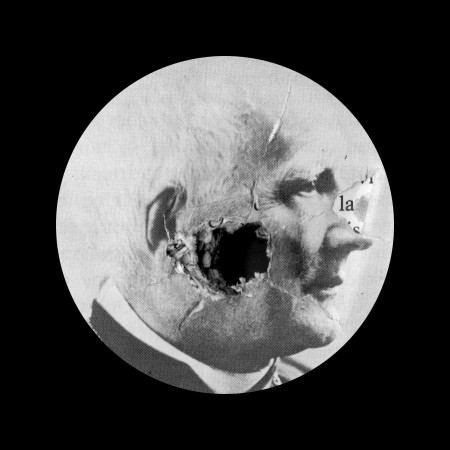
Étienne Tremblay-Tardifâ€ s installation Bookworms, at ARPRIM, is part print exhibition, part performance, and part audience participation. The deafening sounds of drilling accompany a video projected largely onto the gallery’s back wall. The color video is a close up shot of two feet standing on a stack of Quebec history books, and a drill descending into them.
s installation Bookworms, at ARPRIM, is part print exhibition, part performance, and part audience participation. The deafening sounds of drilling accompany a video projected largely onto the gallery’s back wall. The color video is a close up shot of two feet standing on a stack of Quebec history books, and a drill descending into them.
Hung facing each other on either side of the room are 16 square enlargements of portraits of men from inside the pierced books. Each grainy black and white image has drill holes in it that look like bullet holes. Along the holesâ€ edges are rips and fragments of upturned paper bits like edges of pulpy decay, or bizarre textual skin affectations. There is a reverence here, but at the same time a violence to how these men, via their image, are resurrected. It is truly ‘iconophile and iconoclast,â€
edges are rips and fragments of upturned paper bits like edges of pulpy decay, or bizarre textual skin affectations. There is a reverence here, but at the same time a violence to how these men, via their image, are resurrected. It is truly ‘iconophile and iconoclast,â€ as proclaimed in the press release.
as proclaimed in the press release.
On the floor is a carpet of print, composed of books pages, grainy black and white images of violent police encounters from the late sixties and early seventies, and a chronology of events of political violence in Quebec for a decade leading up to 1972. Scattered over top it all are nearly 50, holey Quebec history books. These documents contextualize Quebecâ€ s student uprising by directly referencing the violent aspects of the Quiet Revolutionâ€
s student uprising by directly referencing the violent aspects of the Quiet Revolutionâ€ s legacy. This historical perspective on recent protests raises pointed questions about our history of cultural revolutions, and their violent characterization.
s legacy. This historical perspective on recent protests raises pointed questions about our history of cultural revolutions, and their violent characterization.
With Bookworms, Tremblay-Tardif unearths history and creates questions without ever imposing closure. The history being brought to light so violently never seems to get judged, and no alternative story or discourse is presented to replace it.
To me, Tremblay- Tardifâ€ s act of drilling through history books not only questions the authority represented by the figures on the wall, but completely invalidates it. His drill-hole assassinations obliterate the bearers of a stiflingly exclusive vision of Quebec history. In many ways, a blank space is created for whatever we chose to replace it with. As such, this installation is freeing. Just as Tremblay- Tardif decimates the books, we are allowed to handle and walk all over these documents of history, and think for ourselves about who we are, and where we stand.
s act of drilling through history books not only questions the authority represented by the figures on the wall, but completely invalidates it. His drill-hole assassinations obliterate the bearers of a stiflingly exclusive vision of Quebec history. In many ways, a blank space is created for whatever we chose to replace it with. As such, this installation is freeing. Just as Tremblay- Tardif decimates the books, we are allowed to handle and walk all over these documents of history, and think for ourselves about who we are, and where we stand.
ARPRIM, space #426
Étienne Tremblay- Tardif
Bookworms
2 November- 8 December, 2012
www.arprim.org
The post Étienne Tremblay-Tardif’s Holey History at ARPRIM first appeared on The Belgo Report.
]]>The post The Great Depths of Marie-Jeanne Musiol’s Black Holes first appeared on The Belgo Report.
]]>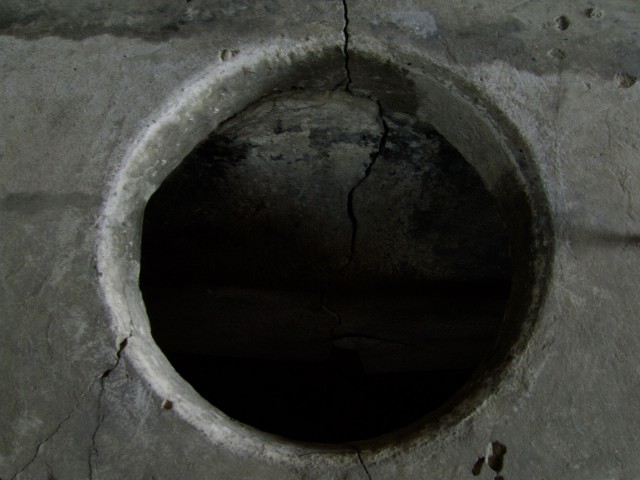
At first glance the photographs in Marie-Jeanne Musiolâ€ s exhibition Black Holes, at the Pierre Francois Ouellette Art Contemporain look like moon-craters, or close-ups of a demolition site. In actuality, they are life-size cement latrine holes built for the Auschwitz-Birkenau concentration camp during the Second World War, each one a part of a larger, single structure where Jews were forced to defecate communally. This degradation was typical of the campâ€
s exhibition Black Holes, at the Pierre Francois Ouellette Art Contemporain look like moon-craters, or close-ups of a demolition site. In actuality, they are life-size cement latrine holes built for the Auschwitz-Birkenau concentration camp during the Second World War, each one a part of a larger, single structure where Jews were forced to defecate communally. This degradation was typical of the campâ€ s strategies of dehumanization. The artistâ€
s strategies of dehumanization. The artistâ€ s previous bodies of work, Bodies of Light (1994-), When the Earth Withholds (1996), In the Shadow of the Forest (Auschwitz-Birkenau) (1998), and Silences (1994-2002),were also thematically linked to the holocaust. With Black Holes, Musiol develops her own peripheral, photographic method to address that trauma.
s previous bodies of work, Bodies of Light (1994-), When the Earth Withholds (1996), In the Shadow of the Forest (Auschwitz-Birkenau) (1998), and Silences (1994-2002),were also thematically linked to the holocaust. With Black Holes, Musiol develops her own peripheral, photographic method to address that trauma.
In a small part of the gallery, dozens of numbered and lettered code names of celestial black holes huddle in a wide band along three walls. In their center are the words ‘Auschwitz-Birkenau,â€ connecting the genocide to the black holes of outer space. In the main room, hung intermittently along the walls, two rows of photographs of black holes in subdued tones of grey encircle the viewer. Throughout the room drifts the chilling recording of wind whistling through the original latrine site.  Holes lit by shafts of light reveal bits of cement detritus at their bottoms. One hole looks like the opening of a throat. Two have mottled grills inside, one of which resembles emaciated ribs. Most holes, however, are completely black.
connecting the genocide to the black holes of outer space. In the main room, hung intermittently along the walls, two rows of photographs of black holes in subdued tones of grey encircle the viewer. Throughout the room drifts the chilling recording of wind whistling through the original latrine site.  Holes lit by shafts of light reveal bits of cement detritus at their bottoms. One hole looks like the opening of a throat. Two have mottled grills inside, one of which resembles emaciated ribs. Most holes, however, are completely black.
Musiol carefully approaches the unknowable experience of internment by using a single banal detail, the concentration camp latrine, as a synecdoche for the horror of genocide. Art historian and curator Celina Jeffery explains how “the incommensurability between the experience and representation [of being in a concentration camp] is dramatized in the black hole which itself appears unrecognizable as an object.â€[1] The photos contain no clear figures, they tell no narrative, and it is through this abstraction that Musiol finds a way to show what cannot be shown.
Pierre-François Ouellette Art Contemporain, space 216
Marie-Jeanne Musiol
Black Holes
September 29 – November 10, 2012
www.pfoac.com
http://www.musiol.ca/index-en.php
[1] Jeffery, Celina. “Contemplating the void: Marie-Jeanne Musiolâ€ s Black Holes.†Prefix Photo Nov.  2012: 17-31. Print.
s Black Holes.†Prefix Photo Nov.  2012: 17-31. Print.
The post The Great Depths of Marie-Jeanne Musiol’s Black Holes first appeared on The Belgo Report.
]]>The post Desolate Diptychs: Catherine Bodmer’s Casas at Optica first appeared on The Belgo Report.
]]>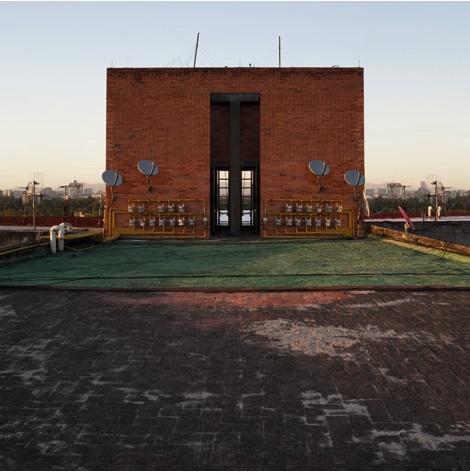
Catherine Bodmerâ€ s signature photographic style of symmetry, digital manipulation and incongruous juxtaposition can be seen in her series Casas, at Optica until October 13. In this set of color diptychs of empty Mexico City roof spaces, the inhabitantsâ€
s signature photographic style of symmetry, digital manipulation and incongruous juxtaposition can be seen in her series Casas, at Optica until October 13. In this set of color diptychs of empty Mexico City roof spaces, the inhabitantsâ€ presence is only implied. (The artist previously explored empty Mexican spaces in her projects Eje sur and Rio Churubusco).
presence is only implied. (The artist previously explored empty Mexican spaces in her projects Eje sur and Rio Churubusco).
Bodmerâ€ s photographs are carefully executed and precisely rendered. Uniformly shot from a centered, and linear perspective, something sad and bleak overtakes each depopulated image. It may be the strangeness of a high vantage point where any view of the city beyond is overwhelmingly obstructed by erected roof structures and adjacent buildings. Or it could be the details that signal class differences in the lives of the buildingâ€
s photographs are carefully executed and precisely rendered. Uniformly shot from a centered, and linear perspective, something sad and bleak overtakes each depopulated image. It may be the strangeness of a high vantage point where any view of the city beyond is overwhelmingly obstructed by erected roof structures and adjacent buildings. Or it could be the details that signal class differences in the lives of the buildingâ€ s inhabitants. Nice tiles and Astroturf in one diptych contrast the raw, discoloured cement of another. Likewise, the power boxes and multiple satellites of the wealthy highlight the poverty of water tanks, beer bottles and lawn chairs.
s inhabitants. Nice tiles and Astroturf in one diptych contrast the raw, discoloured cement of another. Likewise, the power boxes and multiple satellites of the wealthy highlight the poverty of water tanks, beer bottles and lawn chairs.
In Casas the diptych form literally places two versions of a reality side by side. Digital manipulations make details recur and disappear in each symmetrical pair: a beer bottle, stairs, a length of pipe, a row of electric boxes. The work is ironic in the way that it challenges what we take for granted about a location (In a like manner, Bodmerâ€ s Déplacer des montagnes and Narcisse played on these incongruities). Your eyes race back and forth between one image and the next to recover the differences and similarities; you question why they are there and what they could mean.
s Déplacer des montagnes and Narcisse played on these incongruities). Your eyes race back and forth between one image and the next to recover the differences and similarities; you question why they are there and what they could mean.
Nevertheless, any single image from these diptychs could surely stand alone. The showâ€ s only single photograph, “Quinto piso (Susanna)†(2011), for example, is just as complex without being doubled or manipulated. In it, two deep rows of concrete sinks face each other beneath a sliver of open sky.  The outside position of this lavatory implies a perpetually warm climate, yet we see no glimpse of palm trees or blue seas. Here, in a tropical setting, is a place of work and hardship. The thematic of invisibility in Casasâ€
s only single photograph, “Quinto piso (Susanna)†(2011), for example, is just as complex without being doubled or manipulated. In it, two deep rows of concrete sinks face each other beneath a sliver of open sky.  The outside position of this lavatory implies a perpetually warm climate, yet we see no glimpse of palm trees or blue seas. Here, in a tropical setting, is a place of work and hardship. The thematic of invisibility in Casasâ€ rooftop structures glares out quietly, haunting every photograph in the show.
rooftop structures glares out quietly, haunting every photograph in the show.
Optica, Space #508
Catherine Bodmer
Casas
September 8 – October 13, 2012
www.optica.ca
www.catherinebodmer.com/projets_casas.html
The post Desolate Diptychs: Catherine Bodmer’s Casas at Optica first appeared on The Belgo Report.
]]>The post O Lider Invisivel: Stephanie Gervais at Les Territoires first appeared on The Belgo Report.
]]>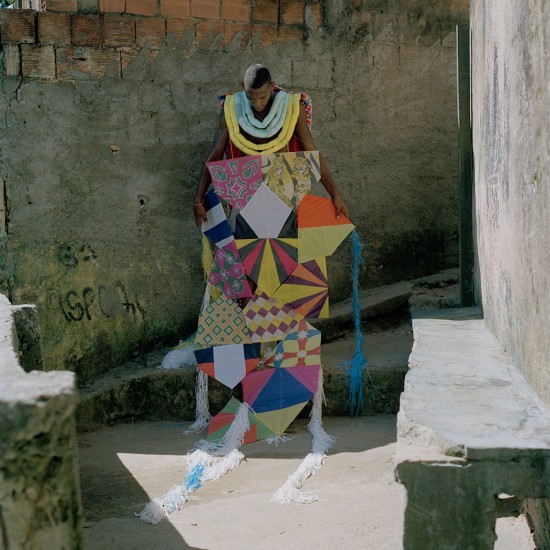
There is a lot going on in American artist Stephanie Gervaisâ€ s exhibition O Lider Invisivel (the invisible leader), showing this month at Les Territories. The performance, photo and video works, created with members of Rio di Janeiroâ€
s exhibition O Lider Invisivel (the invisible leader), showing this month at Les Territories. The performance, photo and video works, created with members of Rio di Janeiroâ€ s Rocinha favela, propose to empower favela Brazilians infantilized by state power and marginalized by mainstream society. The unfortunate undercurrent of these pieces, which results in illogically executed ideas, are the misplaced good intentions of a western artist with an impulse to liberate the oppressed.
s Rocinha favela, propose to empower favela Brazilians infantilized by state power and marginalized by mainstream society. The unfortunate undercurrent of these pieces, which results in illogically executed ideas, are the misplaced good intentions of a western artist with an impulse to liberate the oppressed.
Gervaisâ€ ‘living statuesâ€
‘living statuesâ€ are photographic interruptions of staged performances: costumed men attempt to pay tribute to the spirit of favela culture by combining the honorific characteristics of statues with the ephemeral nature of their community. The artist presents four portraits of men standing in outdoor Rocinha locations, swathed in brightly colored, makeshift garments whose gaudy aesthetic of plastic tassels, kites, flowers, string, and beads is a distorted sartorial echo of carnival culture. Based upon such a thin premise, Gervaisâ€
are photographic interruptions of staged performances: costumed men attempt to pay tribute to the spirit of favela culture by combining the honorific characteristics of statues with the ephemeral nature of their community. The artist presents four portraits of men standing in outdoor Rocinha locations, swathed in brightly colored, makeshift garments whose gaudy aesthetic of plastic tassels, kites, flowers, string, and beads is a distorted sartorial echo of carnival culture. Based upon such a thin premise, Gervaisâ€ s choice to use live Brazilians as her art objects creates an awkward set of caricatures.
s choice to use live Brazilians as her art objects creates an awkward set of caricatures.
Seeking to avoid the prejudice that naturally falls on people from favelas, ‘body postersâ€ veil the body with a poster bearing a transcription of their opinions regarding the void left after the police drove out the drug dealers who acted as community leaders. In these portraits, favela Brazilians wearing face covering headdresses of tiny, multicolored beads hold out big white posters inscribed with quotes of things they have said. This attempt to valorize an oral culture by inserting it into a hierarchy that privileges the written word reinforces the set structure rather than challenging it.
veil the body with a poster bearing a transcription of their opinions regarding the void left after the police drove out the drug dealers who acted as community leaders. In these portraits, favela Brazilians wearing face covering headdresses of tiny, multicolored beads hold out big white posters inscribed with quotes of things they have said. This attempt to valorize an oral culture by inserting it into a hierarchy that privileges the written word reinforces the set structure rather than challenging it.
In all her images, breathtaking natural landscapes contrast with the cement constructions of the favelas. Concrete streets, patios and houses are framed by palm trees, lush green mountains and distant, cloud-wrapped peaks.
Across the room is a looped, single channel video of these photography sessions that pans slowly over the surrounding landscape. A segment of a man, fully costumed, dancing to tinny music in a bare, cement room is followed by up-close footage of people wrapped in body posters.
Gervaisâ€ project is ambitious, but it falls way short of adequately tackling her themes of self-governance, language and empowerment. The ‘body postersâ€
project is ambitious, but it falls way short of adequately tackling her themes of self-governance, language and empowerment. The ‘body postersâ€ meant to empower the speakers literally disembody them. Sure, their speech may gain consequence by being written, but if talkerâ€
meant to empower the speakers literally disembody them. Sure, their speech may gain consequence by being written, but if talkerâ€ s bodies are hidden by these words, are they not being obliterated rather than liberated? Though the handmade costumes the favela Brazilians wear as ‘living statuesâ€
s bodies are hidden by these words, are they not being obliterated rather than liberated? Though the handmade costumes the favela Brazilians wear as ‘living statuesâ€ first appear to stage an authentic, revalorizing identity, what simply and maybe too obviously occurs when the artist uses these images in a north American exhibition, is a nearly farcical objectification of her Brazilian subjects. One is left with the impression that these works would be much more interesting if, instead of the concerns of a community of people, Gervais had used her own impressions as a starting point.
first appear to stage an authentic, revalorizing identity, what simply and maybe too obviously occurs when the artist uses these images in a north American exhibition, is a nearly farcical objectification of her Brazilian subjects. One is left with the impression that these works would be much more interesting if, instead of the concerns of a community of people, Gervais had used her own impressions as a starting point.
Les Territoires, space 527
Stephanie Gervais
O Lider Invisivel
August 10 – September 1st, 2012
http://lesterritoires.org
The post O Lider Invisivel: Stephanie Gervais at Les Territoires first appeared on The Belgo Report.
]]>The post Sans L’autre ou La femme-atelier: Frédérique Ulman-Gagné at Les Territoires first appeared on The Belgo Report.
]]>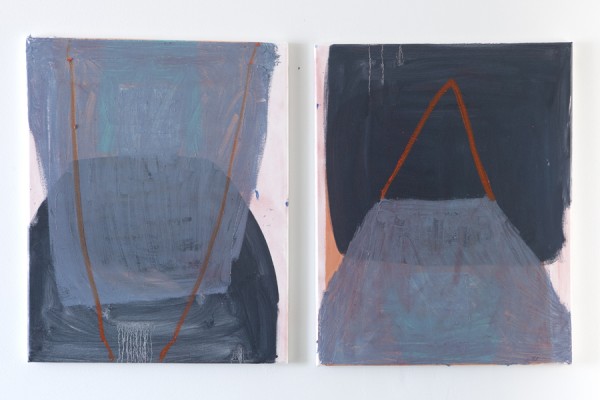
A few years ago, while painting at home and raising a young son, Frédérique Ulman-Gagné tried unsuccessfully to keep her art-work and her mom-work separate. Finally, she saw there was something to learn from her sonâ€ s uninhibited and spontaneous approach, and they began to work together. “Avec ma mere,†the 2010 CDEx exhibition, was the culmination of their collaboration.  When her son enrolled in school Ulman-Gagné began painting in a studio, away from home. Her new body of work, Sans Lâ€
s uninhibited and spontaneous approach, and they began to work together. “Avec ma mere,†the 2010 CDEx exhibition, was the culmination of their collaboration.  When her son enrolled in school Ulman-Gagné began painting in a studio, away from home. Her new body of work, Sans Lâ€ autre ou La Femme Atelier, up till September 1st at Les Territoires, developed from the artistâ€
autre ou La Femme Atelier, up till September 1st at Les Territoires, developed from the artistâ€ s look back on the previous situation, where art space overlapped with home, and the division between the role of mother and artist became blurry. Â
s look back on the previous situation, where art space overlapped with home, and the division between the role of mother and artist became blurry. Â
Sous un drap, Elle sort de la maison, and Le lit défait are a few of the series hung, parlor style, along the galleryâ€ s white walls. Over thirty square frames of varying sizes bear abstractions of triangles, scale designs and line clusters. They are painted with rough, uneven brushstrokes in a wide range of colors. In some places, the layered oils and acrylics take on a thick, bumpy texture, and in others they are barely there, leaving patches of the wood or canvas base untouched.
s white walls. Over thirty square frames of varying sizes bear abstractions of triangles, scale designs and line clusters. They are painted with rough, uneven brushstrokes in a wide range of colors. In some places, the layered oils and acrylics take on a thick, bumpy texture, and in others they are barely there, leaving patches of the wood or canvas base untouched.
In one striking piece, Il lance sa chemise sur le mur, different layers of red, yellow and pink peak from beneath thick, shiny shades of bright red. A flow of blue lines runs horizontally across the frame like a hail of bullets. Â If here the repeated motifs illustrate movement, not all the paintings have such vivacity. In Elle entre dans la maison I, an upside down red triangle hovers over an unstable background of blues. In more sedate works like this one, large details evoke a poignant intimacy.
Ulman-Gagnéâ€ s previous collaboration with her son in a home/work space is not represented in her non-narrative work, instead theses factors surface in the paintings themselves. Like a playful child, they are quick, bright and unruly. The artist links much of their repetitive, abstract motifs to the repetitive tasks of motherhood. In the end, her coarse, indefinite outlines establish a free and open tone for the entire show.
s previous collaboration with her son in a home/work space is not represented in her non-narrative work, instead theses factors surface in the paintings themselves. Like a playful child, they are quick, bright and unruly. The artist links much of their repetitive, abstract motifs to the repetitive tasks of motherhood. In the end, her coarse, indefinite outlines establish a free and open tone for the entire show.
Les Territoires, space 527
Frédérique Ulman-Gagné
Sans Lâ€ autre ou La femme-atelier
autre ou La femme-atelier
August 10-September 1st, 2012
http://lesterritoires.org
The post Sans L’autre ou La femme-atelier: Frédérique Ulman-Gagné at Les Territoires first appeared on The Belgo Report.
]]>The post Skool Summer Research Residencies – Part II first appeared on The Belgo Report.
]]>
In a small, light filled room at the back of Centre des arts actuels Skol, summer residents Charles-Antoine Blais Métivier and Serge-Olivier Rondeau are exploring the ever expanding mass of photographs on Facebook, where over 300 million new photos are posted everyday. For the 8 week duration of their research project, After Faceb00k, they have access to the centreâ€ s space, resources and networks.
s space, resources and networks.
Like documentary photographers of the past, Charles-Antoine and Serge-Olivier are searching for images, but only within the strange, virtual landscape of Facebook photos, where people share the most intimate and banal moments freely. As the pair categorizes and takes stock of their findings, they also think through the many implications of this giant, shifting archive. What kind of platform is Facebook, anyway? Â Although it is privately owned, and all uploaded images can be used by the corporation, we treat it as though it was our own, public commons.
Through their sifting, they are discovering surprising amounts of repetition in the content of photos posted. Could it be that we are all just terrible, unoriginal photographers? If Facebook photos were one day looked at as an archive of how we see ourselves, what would they say about us as a culture?
While they arenâ€ t coming up with any definite answers or conclusions, Charles-Antoine and Serge-Olivierâ€
t coming up with any definite answers or conclusions, Charles-Antoine and Serge-Olivierâ€ s investigation raises important questions about a topic whose insidious significance grows greater everyday.
s investigation raises important questions about a topic whose insidious significance grows greater everyday.
Centre des arts actuels Skol, space 314
Charles-Antoine Blais Métivier and Serge-Olivier Rondeau
After Faceb00k
June 4-August 10, 2012
www.skol.ca
The post Skool Summer Research Residencies – Part II first appeared on The Belgo Report.
]]>The post Skool Summer Research Residencies – Part I first appeared on The Belgo Report.
]]>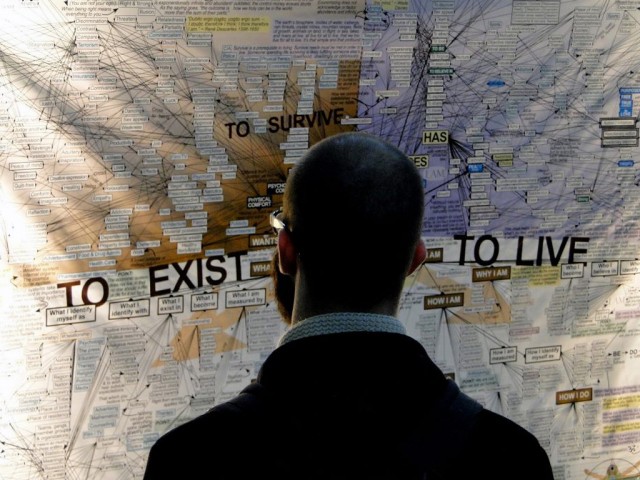
Koby Rogers Hall and Frédéric Biron Carmelâ€ s
s
[p(re)]occupations: The “Living” archives of Occupy Montreal
This summer, the [p(re)]occupations: The “Living” archives of Occupy Montreal research residency at Centre des arts actuels Skol will create a peopleâ€ s history…of sorts. Marked by the spontaneous, non-hierarchical self-organising that distinguished last fallsâ€
s history…of sorts. Marked by the spontaneous, non-hierarchical self-organising that distinguished last fallsâ€ Occupy movement, residents Koby Rogers Hall and Frédéric Biron Carmel are applying that same spirit to the creation of a living record of the movement.
Occupy movement, residents Koby Rogers Hall and Frédéric Biron Carmel are applying that same spirit to the creation of a living record of the movement.
Their first steps were to transform the Skol environment into a place conducive to exchange. Articles, scrawled testimonials and brainstorms and are tacked to the walls. A rough diagram of the Victoria Square encampment faces two perpendicular sofa chairs. From lengths of string stretched mid air between a wall and a post hang different sized notes. A row of chairs nearby awaits an ad-hoc presentation. At a round table, amidst a pile of pens, pencils and blank paper, I sit with the artists to conduct interview that ends, quite literally, in a round-table discussion. Our conversation touches on power, resistance, cyber networks, information, peopleâ€ s histories, accessibility and ephemerality.
s histories, accessibility and ephemerality.
The collaborative aspects of community art, as well as the emancipatory characteristic of (well done) social documentary emerge as the foundations upon which the project aims to build a participatory, bottom- up archive. Hopefully, by the time Koby and Fred present the work in October, the strategies of the living archive will have developed sufficiently to provide a challenge the systemic biases of dominant archiving institutions. The pair will continue their research online, and in workshops and participatory dialogues until August 10th.
Centre des arts actuels Skol, space 314
Koby Rogers Hall and Frédéric Biron Carmel
[p(re)]occupations: The “Living” archives of Occupy Montreal
June 6-August 10, 2012-07-14
www.skol.ca
The post Skool Summer Research Residencies – Part I first appeared on The Belgo Report.
]]>The post Jon Knowles Blood Oranges at Laroche/Joncas first appeared on The Belgo Report.
]]>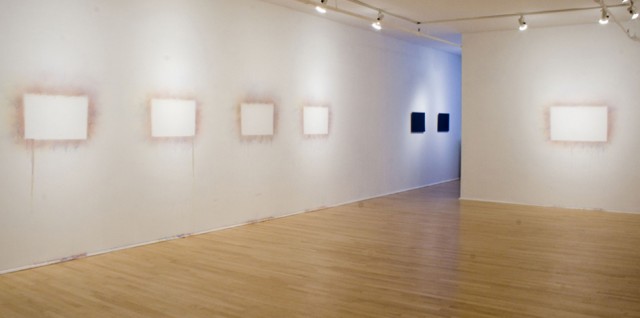
Using absence and displacement Jon Knowlesâ€ show at Galerie Laroche/Joncas makes room for questions and conversations as it lightens the weight of importance usually placed on the artistsâ€
show at Galerie Laroche/Joncas makes room for questions and conversations as it lightens the weight of importance usually placed on the artistsâ€ finished product. Knowles, who is neither a sculptor or a painter, yet shies away from the title conceptual artist, hung a set of paintings begun in 2010 in the gallery and finished them on site, adding layers upon layers of primary colors that rendered their wood bases a nuanced black and created soft, multicoloured clouds around their edges. In this way, he brought the studio to the gallery and left traces of the artistic process all over its walls, drawing a link between the exposition space and the creative act.
finished product. Knowles, who is neither a sculptor or a painter, yet shies away from the title conceptual artist, hung a set of paintings begun in 2010 in the gallery and finished them on site, adding layers upon layers of primary colors that rendered their wood bases a nuanced black and created soft, multicoloured clouds around their edges. In this way, he brought the studio to the gallery and left traces of the artistic process all over its walls, drawing a link between the exposition space and the creative act.
Knowles then removed the paintings and hung them in the galleryâ€ s back room, leaving only framed outlines of white rectangles along the walls. On June 16th and 23th they were moved yet again for a special viewing in the Hyatt Regency hotel room that overlooks the MAC. Placing the finished paintings outside the white cube space of the gallery brought them away from where art is quietly contemplated into area where discussions are more likely to occur. Knowlesâ€
s back room, leaving only framed outlines of white rectangles along the walls. On June 16th and 23th they were moved yet again for a special viewing in the Hyatt Regency hotel room that overlooks the MAC. Placing the finished paintings outside the white cube space of the gallery brought them away from where art is quietly contemplated into area where discussions are more likely to occur. Knowlesâ€ playful experiment is rich in thought and a delight to observe.
playful experiment is rich in thought and a delight to observe.
Galerie Laroche/Joncas, space 410
Jon Knowles
Blood Oranges
June 13– July 22, 2012
www.larochejoncas.com
See John Knowles concurrent solo show, Mixed Misuse, at the Darling Foundry until September 2nd.
The post Jon Knowles Blood Oranges at Laroche/Joncas first appeared on The Belgo Report.
]]>